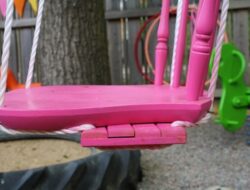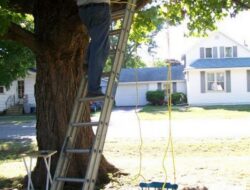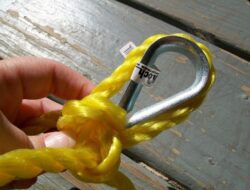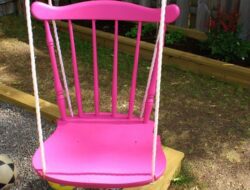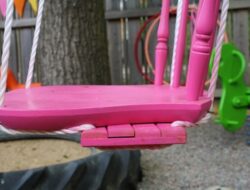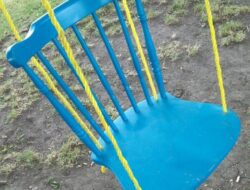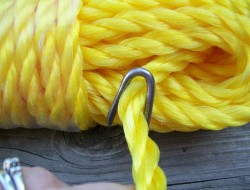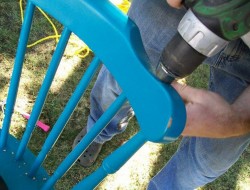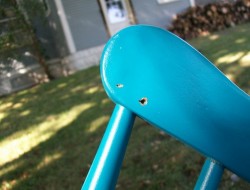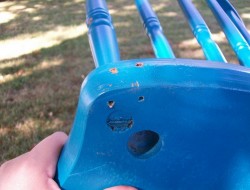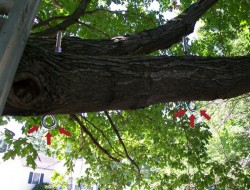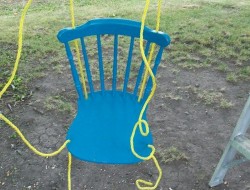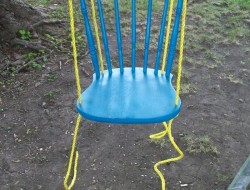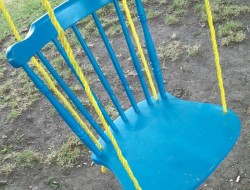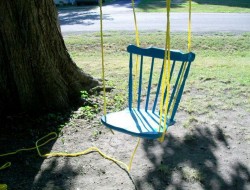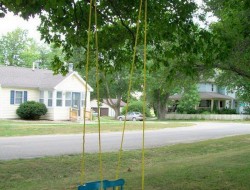Last Updated on April 8, 2025 by teamobn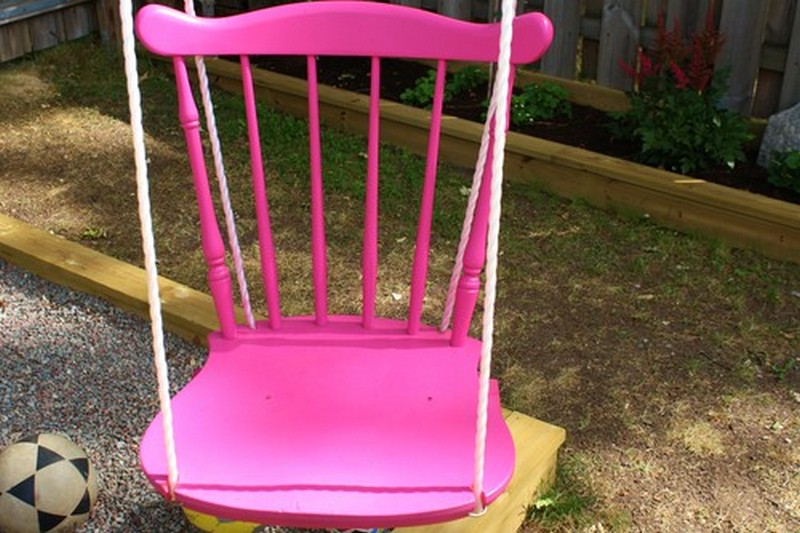
Have you got an old chair that could do with a new life? Why not turn it into this DIY chair tree swing!
Rather than toss your old broken chairs, why not try giving them a makeover for your own or as a gift for your cute kids.
Create a Unique DIY Tree Chair Swing
Many people toss out old broken chairs, but if you are feeling crafty and have some time to kill, why not try giving them a makeover? This is a great way to repurpose something to use around your home or a great way to give them a new life.
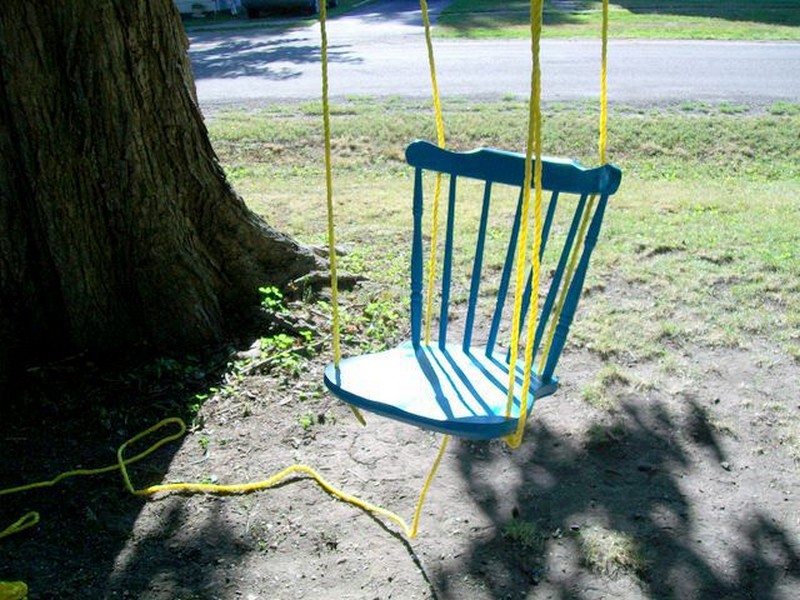
The chair swing is a very popular summertime activity for kids of all ages. It is basically a swing made out of a chair with rope tied to the legs.
The swing is placed high up in a tree or other structure and the rope tied to a branch or sturdy part of the tree. The person sits on the chair and holds the rope with their hands.
Your kids can then swing back and forth as they please. Just make sure that the chair is able to support your weight so you don’t fall out and hurt yourself.
All you need to do is to attach some ropes to it and hang it on a tree with heavy-duty bolts and washers. Now isn’t this the easiest swing to make?
Materials:
- Old Chair
- 3/8” Poly Rope
- 2 pcs Eye Bolts
- 4 Heavy Duty Washers
- 2 Lock Washers
- Spray Paint
- Clear Coat
- Ladder
Tools:
- Drill
- Paintbrush
Steps:
Make sure that the chair can still support your weight. We need to ensure that the users are safe upon using the chair tree swing.
Basically, you will need to cut two ropes to thick vines also work but they have to be strong enough to hold your weight for your chair tree swing.
Then you need to tie the ropes/vines to the front legs of the chair and onto something else that can support your weight (e.g. a tree branch). You need to be able to learn at least a basic knot. The most popular knot you can use is the bowline knot.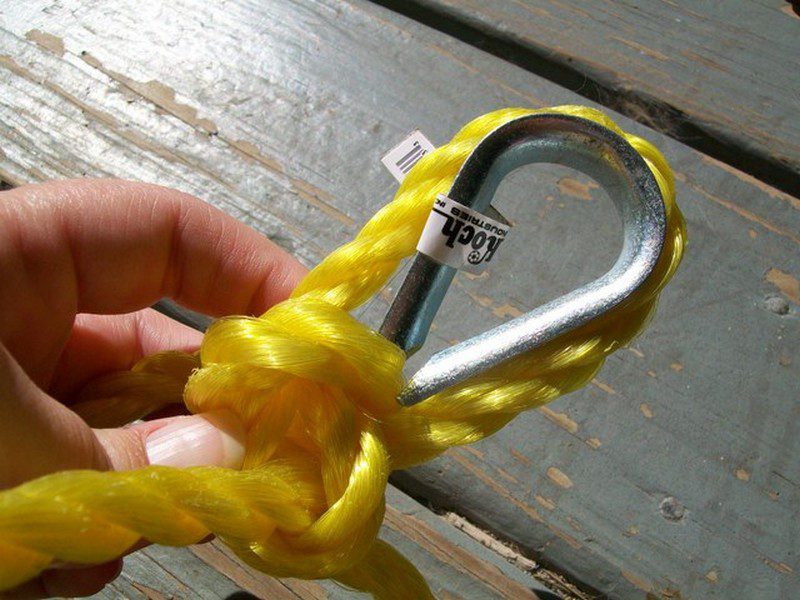
A simple and secure knot, the Bowline is one of the most useful knots you can learn. It can be used to secure a line to a solid object, and is especially useful if you need to tie the object to something that moves.
The Bowline knot is easy to learn and can be tied using rope, cord, fishing line or other similar materials. This will make your chair tree swing safe for the users, especially it has backrest that the user can lean on while swinging.
You can paint the chairs if you want to make it look better. 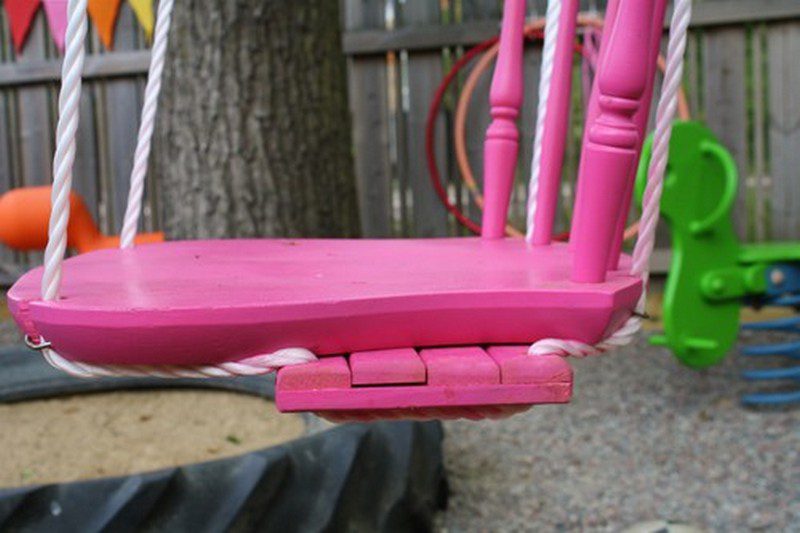
Now, you can put on your child’s helmet and safety goggles and stand on the seat and pull the ropes/vines to start enjoying your chair tree swing!
The kids will surely love this… and so will kids at heart! Do you think this chair tree swing will be a good weekend past time project idea? If you do, start gathering all materials that you’ll be needing.
Ask your partner or kids to help you with this project, you will not only have a good swing to enjoy, but also a good family time together.
Safety Tips for Installing Your Tree Chair Swing
Before installing your DIY tree chair swing, it’s crucial to consider safety. While a chair swing offers endless outdoor enjoyment, improper installation or overlooking safety guidelines can lead to injuries. Taking a few precautions ensures your swing is sturdy, reliable, and ready to provide safe fun for your family. Here are several essential safety tips to remember while installing your tree chair swing.
Selecting a Suitable Tree
The tree you choose significantly influences the swing’s safety and durability. Opt for a healthy, mature tree that can reliably hold substantial weight. Check for visible signs of disease, rot, or insect infestations. Trees such as oak, maple, or sturdy hardwood varieties are often the best choices. Avoid evergreens or trees with weak, thin branches, as they’re likely to snap or bend. Branch thickness should be at least eight inches in diameter to safely bear the weight and withstand movement. Ensuring the tree’s strength is the first vital step in creating a secure swing.
Inspecting and Preparing the Chair
Selecting a structurally sound chair is essential. Inspect the chair thoroughly, checking all joints, legs, and seat supports for cracks or weaknesses. Ensure the seat and backrest can withstand pressure without breaking. Tighten or reinforce any loose components, and avoid using chairs with brittle plastic or damaged wood. If you doubt the chair’s integrity, it’s safer to choose another. Also, sanding down rough edges and finishing the chair with weather-resistant paint or sealant prevents deterioration from exposure and further enhances safety.
Using Proper Hardware and Ropes
Investing in quality hardware and ropes reduces the risk of accidents significantly. Always use heavy-duty eye bolts, washers, and lock nuts that securely anchor the ropes to the chair. Ensure the rope you select is suitable for outdoor use, resistant to weather damage, and strong enough to support the maximum intended weight—polypropylene ropes around 3/8-inch thickness usually work well. Replace ropes immediately if they show signs of fraying or wear, and never reuse ropes that previously supported heavy loads.
Choosing the Right Knot and Rope Length
Learning a reliable knot is critical to swing safety. The bowline knot is a popular and highly recommended choice due to its strength and reliability under tension. It doesn’t slip or loosen easily and is simple enough to tie correctly every time. Measure rope lengths carefully, allowing enough space to comfortably swing but not excessively long to avoid risk of injury. Ideally, the swing should hang 18–24 inches above the ground, allowing safe entry and exit without causing scraping or contact with the surface during use.
Regular Inspections and Maintenance
Routine inspections play a vital role in maintaining swing safety. Frequently check the tree branch, ropes, chair, and hardware for signs of wear or damage. Weather, especially rain, sun exposure, and temperature extremes, can gradually degrade materials. Tighten bolts and check rope knots regularly. Any worn-out components should be replaced immediately to avoid unexpected accidents. Remove or store the swing during extreme weather conditions or winter months to prolong its lifespan and maintain safety.
Ensuring Safe Swing Use
Lastly, always emphasize safe swing practices to users, especially children. Avoid excessive swinging or twisting movements, as this can weaken ropes and hardware over time. Ensure only one person uses the swing at a time and always supervise younger children during play.
Following these essential safety tips ensures your tree chair swing will offer joyful, carefree hours outdoors, providing peace of mind and lasting family enjoyment.
Tree Chair Swing Gallery
Click on any image to start lightbox display. Use your Esc key to close the lightbox. You can also view the images as a slideshow if you prefer 😎
Choosing the Perfect Chair for Your Swing
Choosing the right chair for your tree swing makes a significant difference in safety, durability, and overall enjoyment. The perfect chair not only adds visual appeal but ensures comfortable swinging sessions for you and your family. It’s essential to pick a chair that’s structurally sound and compatible with outdoor use. Here are important considerations to help you select the ideal chair for transforming into your backyard tree swing.
Consider the Chair’s Material
Start by evaluating the material of your chair. Wooden chairs are typically the best choice due to their strength, durability, and ease of customization. Solid hardwood chairs, like oak or maple, offer superior durability and resistance to outdoor elements. Softwood chairs, like pine, are acceptable but require regular maintenance and sealing to withstand moisture.
Avoid plastic chairs, which are prone to cracking under pressure, and metal chairs, as they may rust or corrode over time, compromising safety. Opting for a sturdy wooden chair ensures your swing will last through multiple seasons.
Check Structural Integrity
Always inspect the chair carefully before converting it into a swing. Structural integrity is vital, so examine each joint, seat, legs, and backrest thoroughly. Shake the chair gently and listen for creaks or movement that might indicate loose joints or instability. Chairs with broken slats, loose screws, cracks, or splintered areas aren’t suitable candidates for swings. If the chair wobbles or has structural damage, select another chair or perform necessary repairs before use.
Size and Comfort Matter
Comfort is essential when enjoying a relaxing swing, so consider the size and ergonomics of the chair. Make sure the seat area is large enough to comfortably accommodate the intended user. Chairs with supportive backrests and curved seats are preferable, as they provide stability and a pleasant swinging experience. Additionally, check that the seat isn’t excessively narrow or shallow, which could lead to discomfort or a potential risk of falling.
Weight Capacity and Stability
Knowing the weight capacity of the chair ensures safety for all swing users. Choose chairs designed to withstand heavier loads if adults or teenagers will use the swing regularly. Vintage or antique chairs often have a robust structure ideal for swing conversions, but double-check stability first. A reliable chair should hold weight easily without bending or warping. For added confidence, reinforce weak points, tighten bolts, or add extra hardware as needed.
Easy Customization and Weather Resistance
Look for chairs you can customize easily for outdoor conditions. Wooden chairs typically accept paint, varnish, or protective sealants readily, extending the lifespan of your swing. Chairs that already show some weather resistance, like those treated with outdoor finishes, can save time and effort. Still, a fresh coat of weather-resistant paint or clear coat sealant is always a smart investment to protect your swing from moisture and sun damage.
Visual Appeal and Personal Style
Lastly, don’t overlook aesthetics when choosing your chair. Consider how the chair fits with your backyard style. Vintage chairs offer charm and nostalgia, while sleek, minimalist chairs create a modern look. Choosing an attractive chair or decorating it with cheerful colors or patterns not only adds visual appeal but makes your swing a delightful focal point in your outdoor space.
By carefully selecting a sturdy, comfortable, and visually appealing chair, you’ll create the perfect DIY tree swing that combines safety, durability, and style.
Conclusion
Building a tree chair swing offers a wonderful way to repurpose old furniture, creating lasting memories in your backyard. With careful chair selection, sturdy materials, and attention to safety, you’ll have a swing that’s both enjoyable and safe for everyone. Regular maintenance ensures your creation remains a cherished spot for relaxation and play. Enjoy the satisfaction of transforming something forgotten into your family’s favorite outdoor spot.
If you liked this project, you would also like to view these swings…

